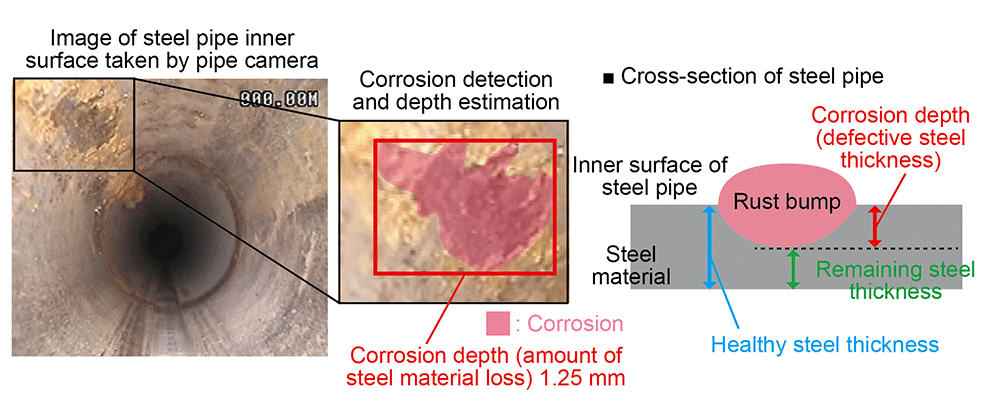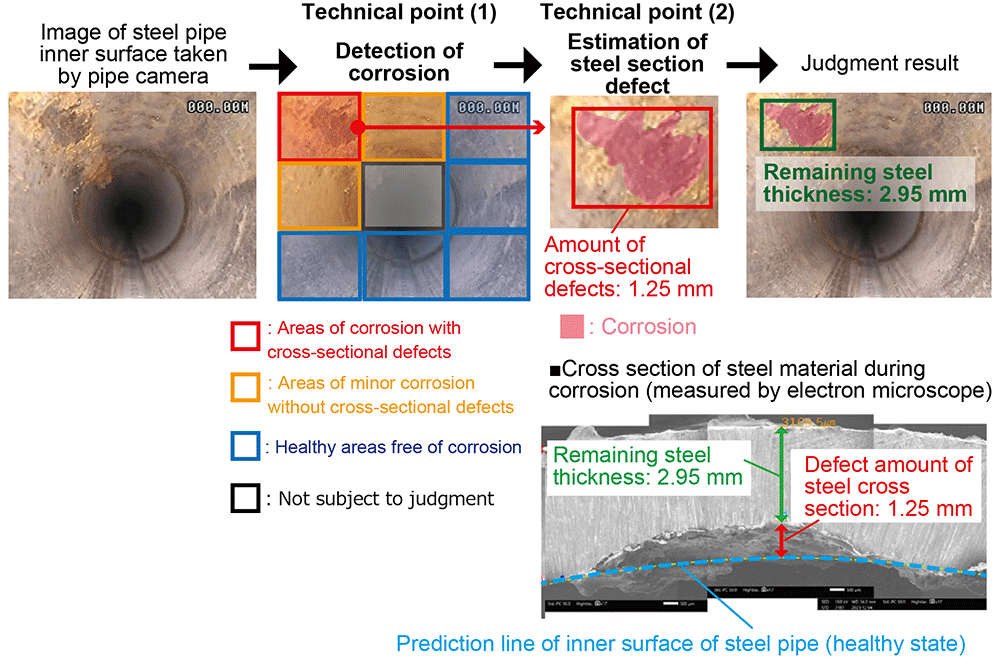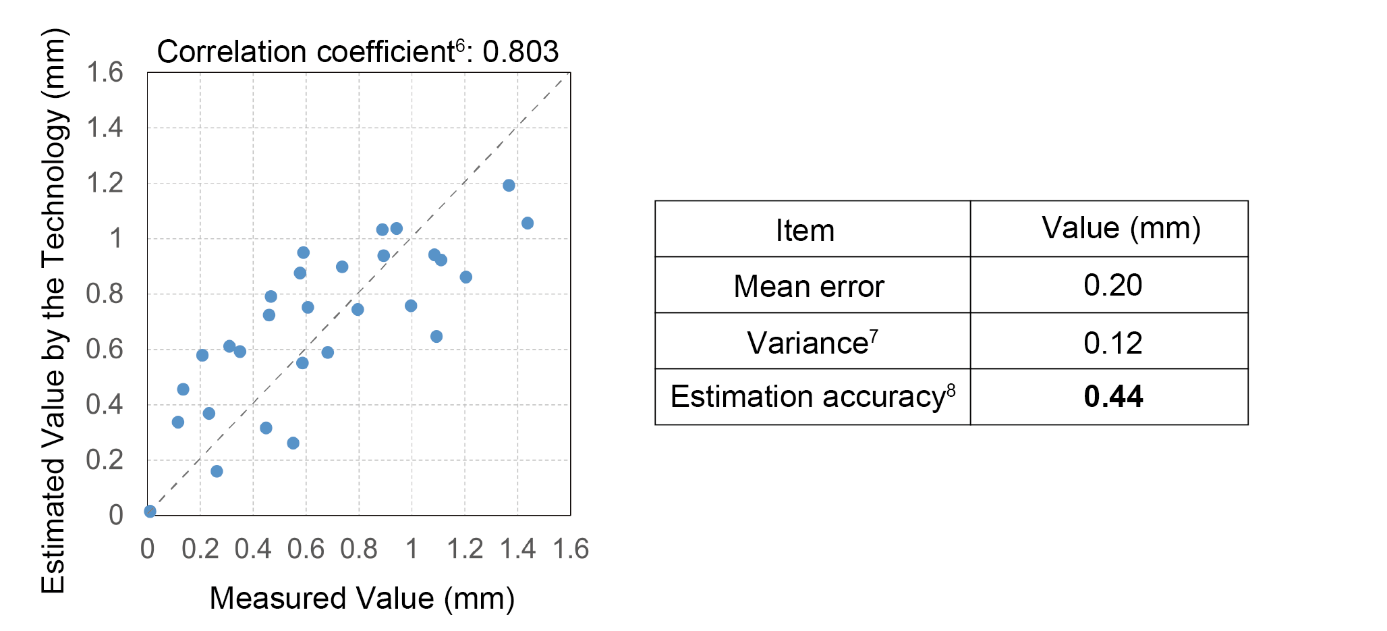Microsoft ends support for Internet Explorer on June 16, 2022.
We recommend using one of the browsers listed below.
- Microsoft Edge(Latest version)
- Mozilla Firefox(Latest version)
- Google Chrome(Latest version)
- Apple Safari(Latest version)
Please contact your browser provider for download and installation instructions.
May 13, 2024
NTT Corporation
Established a technology to automatically estimate the depth of corrosion on steel materials in infrastructure facilities from images
Achieve lower maintenance costs through high-precision diagnosis of equipment durability and load-bearing capacity
News Highlights:
- We established a technology to estimate the depth of corrosion (the amount of defect in the steel section due to corrosion) of steel materials from images taken of infrastructure facilities.
- Estimation of the amount of defect in the cross section of the steel pipe line1 (steel pipe) with an accuracy of 0.44 mm error
- The remaining steel thickness of infrastructure equipment can be measured, enabling highly accurate diagnosis of the durability and load-bearing capabilities of facilities2,3 and reduction of maintenance costs by appropriate repairs at appropriate times and methods.
Tokyo — May 13, 2024 — NTT Corporation (NTT) has established an image recognition technology that automatically detects corrosion of steel materials from images taken of infrastructure facilities using a digital camera and estimates the depth of corrosion (the amount of loss in a steel section due to corrosion). As a result of verification using steel pipeline facilities, it was confirmed that the defect amount of the steel section can be estimated with an accuracy of 0.44 mm.
This technology can automatically grasp the corroded areas of the equipment and the thickness of the remaining steel material from the images, enabling highly accurate evaluation of equipment durability and load-bearing performance. This reduces maintenance costs by allowing repairs to be performed in a timely manner.
This technology is scheduled to be put into practical use at NTT Group companies by the end of FY2024. NTT will contribute to the realization of a sustainable society by expanding the technology to other infrastructure facilities such as bridges, steel towers, and guardrails.
This technology will be introduced at the Tsukuba Forum 20244 scheduled to be held from, May 16-17, 2024.
 Figure 1 Detection of corrosion and estimation of corrosion depth from images of steel pipes taken by a digital camera
Figure 1 Detection of corrosion and estimation of corrosion depth from images of steel pipes taken by a digital camera
1. Background
Many steel structures such as bridges, steel towers and guardrails have been installed, and the aging of infrastructure facilities is a major social problem. The main cause of deterioration of these facilities is corrosion of steel. Corrosion in the equipment causes the steel to lose its cross section as it progresses, and the durability and load resistance of the equipment gradually deteriorate, which may eventually lead to damage or collapse. Therefore, it is important for the facility manager to inspect the deterioration condition to properly diagnose the remaining durability and load-bearing capacity.
However, it is difficult to accurately evaluate the remaining durability and load-bearing capacity using the current inspection method. Steel thickness is essential for structural calculations to accurately evaluate durability and load-bearing performance. However, at present, the depth of corrosion (the amount of defect in the steel section due to corrosion) cannot be ascertained because workers visually inspect the exterior of the equipment. There is a method to measure the thickness of steel using ultrasonic waves, but it is not practical because a probe needs to be placed at the measuring point, which requires a lot of work cost for the entire facility. In addition, inspections of large structures such as bridges may require the installation of scaffolding and other costs.
A simple and low-cost method for measuring the thickness of steel materials is necessary for the maintenance of safe and secure facilities by highly accurate diagnosis of steel structures.
2. Technology Overview
We have established an image recognition technology that automatically detects corrosion from images of steel structures taken with a digital camera and estimates the amount of defects in steel sections due to corrosion. his technology was established using steel conduit facilities (steel pipes), which are telecommunication infrastructure facilities owned by NTT (Figure 1).
[Technical Points]
(1) Corrosion detection:
The areas are classified into areas where minor corrosion has occurred without defects in the steel section, areas where corrosion has occurred with defects in the section, and healthy areas where no corrosion has occurred. This allows quantitative determination of the areas of highly monitored corrosion with defects in steel sections.
(2) Estimation of steel section defect:
Highly accurate estimation is achieved by building a machine learning model using NTT's proprietary database. Among the various appearance features that change with the progress of corrosion, such as the extent of corrosion, color, and the size of the rust hump, we clarified the features that are highly related to the amount of defect in the steel section. Based on this feature, corrosion images with various degrees of progress were grouped, and corrosion images and cross-sectional defect measurements in the images were prepared so that each group was sufficiently and equally corroded.
The high-quality database constructed by selecting images based on appropriate features and accurately measuring the amount of defects enables highly accurate estimation of defects. The image in Figure 1 shows the inner surface of a steel pipe photographed using a pipe camera5. In detecting corrosion, areas of corrosion with cross-sectional defects are detected. The amount of loss in the pipe cross-section is then estimated by analyzing the degree of corrosion progression. Finally, since the thickness of the communication steel pipe is 4.20 mm in its sound state, the remaining steel thickness in the corroded area can be calculated to be 2.95 mm by subtracting the amount of sectional loss.
 Figure 2 Estimation of Steel Thickness of Steel Pipe Using this Technology
Figure 2 Estimation of Steel Thickness of Steel Pipe Using this Technology
3. Validation Overview
(1) Verification Contents
Using the steel pipe installed at the site, we photographed the inner surface of the steel pipe with a pipe camera. Using this technique, we estimated the amount of loss in the steel section due to corrosion from the images. In addition, steel pipes were cut in the cross section direction at 30 corrosion points estimated by this technology, and the amount of defect in the cross section was measured using an electron microscope (Figure 2).
(2) Validation results
Figure 3 shows the measured values of defects in steel sections of steel pipes and the results of the estimated values using this technology. The correlation coefficient6 was 0.803, confirming a high correlation. The average error of the estimated value was 0.20 mm, and the variance7 was 0.12 mm. Based on these results, it was confirmed that the defect amount of the steel section could be estimated with an accuracy of an error of ±0.44 mm.8
 Figure 3 Verification Results of this Technology
Figure 3 Verification Results of this Technology
4. Effects of this technology and future development
This technology enables us to quantitatively grasp the thickness of steel materials in structures, so that we can accurately diagnose the remaining durability and load-bearing capacity. This allows repairs to be performed in an appropriate time and manner, ensuring safe and secure facility functions and reducing maintenance costs.
NTT Group companies plan to commercialize this technology in fiscal 2024. In addition, we will contribute to the realization of a sustainable society by solving problems such as an increase in the maintenance and management costs of the entire social infrastructure by applying the system to various infrastructure facilities such as bridges, steel towers and guardrails.
1Steel pipeline
Pipes used for storing or delivering communication/electrical cables, gas, water, etc.
2Endurance performance
Physical service life until the equipment becomes obsolete and unusable
3Load-bearing performance
Performance by which the equipment can withstand the actual operating loads
4Tsukuba Forum 2024
https://www.tsukuba-forum.jp/e/index.html
5Pipe camera
It is a small camera device used for the inspection of a pipeline, capable of capturing images of the inner surface of the pipeline.
6Correlation coefficient
An index that measures the strength of a linear relationship between two sets of data. The closer the coefficient is to 1, the stronger the positive relationship.
7Variance
Standard deviation (σ) of the estimation error of the defect amount of the cross section by this technique
8Accuracy/estimation accuracy
95% confidence interval (2σ)
About NTT
NTT contributes to a sustainable society through the power of innovation. We are a leading global technology company providing services to consumers and businesses as a mobile operator, infrastructure, networks, applications, and consulting provider. Our offerings include digital business consulting, managed application services, workplace and cloud solutions, data center and edge computing, all supported by our deep global industry expertise. We are over $97B in revenue and 330,000 employees, with $3.6B in annual R&D investments. Our operations span across 80+ countries and regions, allowing us to serve clients in over 190 of them. We serve over 75% of Fortune Global 100 companies, thousands of other enterprise and government clients and millions of consumers.
Media contact
NTT Information Network Laboratory Group
Public Relations
nttrd-pr@ml.ntt.com
Information is current as of the date of issue of the individual press release.
Please be advised that information may be outdated after that point.
NTT STORY
WEB media that thinks about the future with NTT










